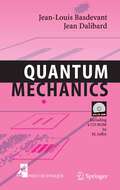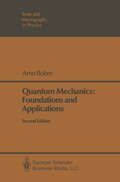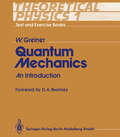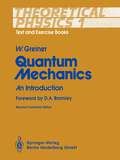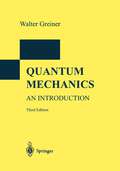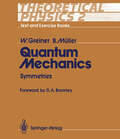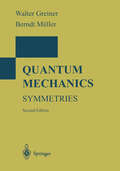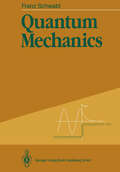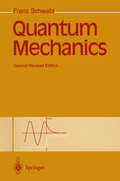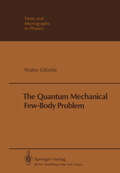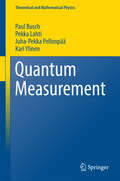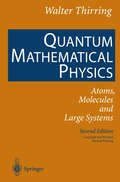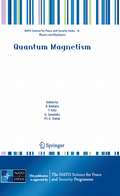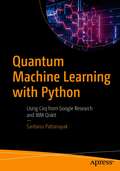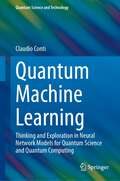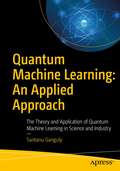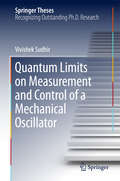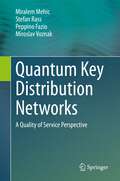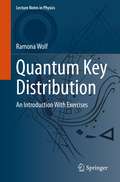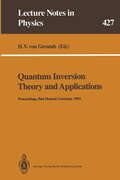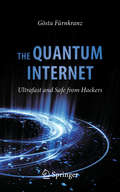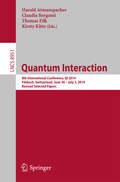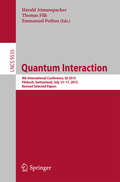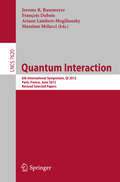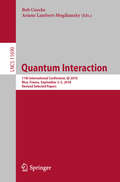- Table View
- List View
Quantum Mechanics
by Jean-Louis Basdevant Jean DalibardGives a fresh and modern approach to the field. It is a textbook on the principles of the theory, its mathematical framework and its first applications. It constantly refers to modern and practical developments, tunneling microscopy, quantum information, Bell inequalities, quantum cryptography, Bose-Einstein condensation and quantum astrophysics. The book also contains 92 exercises with their solutions.
Quantum Mechanics: Foundations and Applications (Theoretical and Mathematical Physics)
by Arno BöhmThe first edition of this book was written as a text and has been used many times in a one-year graduate quantum mechanics course. One of the reviewers has made me aware that the book can also serve as, " . . . in principle, a handbook of nonrelativistic quantum mechanics. " In the second edition we have therefore added material to enhance its usefulness as a handbook. But it can still be used as a text if certain chapters and sections are ignored. We have also revised the original presentation, in many places at the suggestion of students or colleagues. As a consequence, the contents of the book now exceed the material that can be covered in a one-year quantum mechanics course on the graduate level. But one can easily select the material for a one-year course omitting-according to one's preference-one or several of the following sets of sections: {1. 7, XXI}, {X, XI} or just {XI}, {II. 7, XIII}, {XIV. 5, XV}, {XIX, XX}. Also the material of Sections 1. 5-1. 8 is not needed to start with the physics in Chapter II. Chapters XI, XIII, XIX, and XX are probably the easiest to dispense with and I was contemplating the deletion of some of them, but each chapter found enthusiastic supporters among the readers who advised against it. Chapter I-augmented with some applications from later chapters-can also be used as a separate introductory text on the mathematics of quantum mechanics.
Quantum Mechanics: An Introduction
by Walter GreinerQuantum Dynamics is a major survey of quantum theory based on Walter Greiner's long-running and highly successful course at the University of Frankfurt. The key to understanding in quantum theory is to reinforce lecture attendance and textual study by working through plenty of representative and detailed examples. Firm belief in this principle led Greiner to develop his unique course and to transform it into a remarkable and comprehensive text. The text features a large number of examples and exercises involving many of the most advanced topics in quantum theory. These examples give practical and precise demonstrations of how to use the often subtle mathematics behind quantum theory. The text is divided into five volumes: Quantum Mechanics I - An Introduction, Quantum Mechanics II - Symmetries, Relativistic Quantum Mechanics, Quantum Electrodynamics, Gauge Theory of Weak Interactions. These five volumes take the reader from the fundamental postulates of quantum mechanics up to the latest research in particle physics. Volume 1, Quantum Mechanics I - An Introduction, lays the foundation for the rest of the course. Starting from black-body radiation, the photo-electric effect and wave-particle duality, Greiner goes on to discuss the uncertainty relations, spin and many-body systems, then discusses applications to the hydrogen atom and the Stern-Gerlach and Einstein-de Haas experiments. The mathematics of representation theory, S-matrices, perturbation theory, eigenvalues and hypergeometric differential equations are presented in detail, with 84 fully and carefully worked examples and exercises to consolidate the material. Volume 2 presents a particularly appealing and successful theme in advanced quantum mechanics - symmetries. After a brief introduction to symmetries in classical mechanics, the text turns to their relevance in quantum mechanics, the consequences of rotation symmetry and the general theory of Lie groups. The Isospin group, hypercharge, SU (3) and their applications are all dealt with in depth before a chapter on charm and SU (3) leads to the frontiers of research in particle physics. Almost a hundred detailed, worked examples and problems make this a truly unique text on a fascinating side of modern physics.
Quantum Mechanics: An Introduction
by Walter GreinerMore than a generation of Gennan-speaking students around the world have worked their way to an understanding and appreciation of the power and beauty of modem theoretical physics - with mathematics, the most fundamental of sciences - using Waiter Greiner's textbooks as their guide. The idea of developing a coherent, complete presentation of an entire field of science in a series of closely related textbooks is not a new one. Many older physicists remember with real pleasure their sense of adventure and discovery as they worked their ways through the classic series by Sommerfeld, by Planck and by Landau and Lifshitz. From the students' viewpoint, there are a great many obvious advantages to be gained through use of consistent notation, logical ordering of topics and coherence of presentation; beyond this, the complete coverage of the science provides a unique opportunity for the author to convey his personal enthusiasm and love for his subject. The present five volume set, Theoretical Physics, is in fact only that part of the complete set of textbooks developed by Greiner and his students that presents the quantum theory. I have long urged him to make the remaining volumes on classical mechanics and dynamics, on electromagnetism, on nuclear and particle physics, and on special topics available to an English-speaking audience as well, and we can hope for these companion volumes covering all of theoretical physics some time in the future.
Quantum Mechanics: An Introduction
by Walter GreinerThe text Quantum Mechanics - An Introduction has found many friends among physics students and researchers so that the need for a third edition has arisen. There was no need for a major revision of the text but I have taken the opportunity to make several amendments and improvements. A number of misprints and minor errors have been corrected and a few clarifying remarks have been added at various places. A few figures have been added or revised, in particular the three-dimensional density plots in Chap. 9. I am grateful to several colleagues for helpful comments, in particular to Prof. R.A. King (Calgary) who supplied a comprehensive list of corrections. I also thank Dr. A. Scherdin for help with the figures and Dr. R. Mattiello who has supervised the preparation of the third edition of the book. Furthermore I acknowledge the agreeable collaboration with Dr. H. 1. Kolsch and his team at Springer-Verlag, Heidelberg.
Quantum Mechanics: Symmetries
by Walter Greiner Berndt Müller"Quantum Dynamics" is a major survey of quantum theory based on Walter Greiner's long-running and highly successful courses at the University of Frankfurt. The key to understanding in quantum theory is to reinforce lecture attendance and textual study by working through plenty of representative and detailed examples. Firm belief in this principle led Greiner to develop his unique course and to transform it into a remarkable and comprehensive text. The text features a large number of examples and exercises involving many of the most advanced topics in quantum theory. These examples give practical and precise demonstrations of how to use the often subtle mathematics behind quantum theory. The text is divided into five volumes: Quantum Mechanics I - An Introduction, Quantum Mechanics II - Symmetries, Relativistic Quantum Mechanics, Quantum Electrodynamics, Gauge Theory of Weak Interactions. These five volumes take the reader from the fundamental postulates of quantum mechanics up to the latest research in particle physics. Volume 2 presents a particularly appealing and successful theme in advanced quantum mechanics - symmetries. After a brief introduction to symmetries in classical mechanics, the text turns to their relevance in quantum mechanics, the consequences of rotation symmetry and the general theory of Lie groups. The Isospin group, hypercharge, SU (3) and their applications are all dealt with in depth before a chapter on charm and SU (3) leads to the frontiers of research in particle physics. Almost a hundred detailed, worked examples and problems make this a truly unique text on a fascinating side of modern physics.
Quantum Mechanics: Symmetries
by Walter Greiner Berndt MüllerGreiner's lectures, which underlie these volumes, are internationally noted for their clarity, their completeness and for the effort that he has devoted to making physics an integral whole; his enthusiasm for his science is contagious and shines through almost every page. These volumes represent only a part of a unique and Herculean effort to make all of theoretical physics accessible to the interested student. Beyond that, they are of enormous value to the professional physicist and to all others working with quantum phenomena. Again and again the reader will find that, after dipping into a particular volume to review a specific topic, he will end up browsing, caught up by often fascinating new insights and developments with which he had not previously been familiar. Having used a number of Greiner's volumes in their original German in my teaching and research at Yale, I welcome these new and revised English translations and would recommend them enthusiastically to anyone searching for a coherent overview of physics.
Quantum Mechanics
by Franz SchwablA student's first course on quantum mechanics provides the foundation essential for much of his or her future work in physics, be it in atomic, elementary particle, or solid state physics. This introductory textbook contains not only the foundations and many applications of quantum mechanics, but also new aspects and their experimental verification. It has as its particular virtues clarity and conciseness of presentation, while at the same time being self-contained. Comprehensibility is further guaranteed by the inclusion of all the mathematical steps required for a complete understanding. Carefully chosen problems help to consolidate the student's knowledge. In the introductory chapters, starting from the historical evolution of the subject, the fundamental postulates are developed inductively by means of an interference experiment. Thereafter the structure is purely deductive, covering all of nonrelativistic quantum mechanics, plus the quantization of the radiation field in the context of optical transitions. As well as the quantum mechanical "essentials", for instance, detailed treatments of scattering theory, time dependent phenomena, and the density matrix, such topics as the theory of quantum mechanical measurement and the Bell inequality are dis- cussed. A separate chapter is devoted to supersymmetric quantum mechanics, an area which to date has been accessible only in the research literature.
Quantum Mechanics
by Franz SchwablIn the new edition supplements have been added at various places, includ ing the formulation of some of the problems. In all these additions I have attempted not to change the compact character of the book. The present (second) English edition is, besides the problems and smaller corrections, identical to the current German fourth edition. The proofs were read by B. Kaufmann, M. Hummel and A. Vilfan. I would like to thank all colleagues and students who made suggestions to improve the book as well as the pub lisher. Special thanks go to S. Clar for preparing the new 'JEX file. Munich, March 1995 F. Schwabl Preface to the First Edition This is a textbook on quantum mechanics. In an introductory chapter, the ba sic postulates are established, beginning with the historical development, by the analysis of an interference experiment. From then on the organization is purely deductive. In addition to the basic ideas and numerous applications, new aspects of quantum mechanics and their experimental tests are pre sented. In the text, emphasis is placed on a concise, yet self-contained, presen tation. The comprehensibility is guaranteed by giving all mathematical steps and by carrying out the intermediate calculations completely and thoroughly.
The Quantum Mechanical Few-Body Problem (Theoretical and Mathematical Physics)
by W. GlöckleFew-body systems are both technically relatively simple and physically non trivial enough to test theories quantitatively. For instance the He-atom played historically an important role in verifying predictions of QED. A similar role is contributed nowadays to the three-nucleon system as a testing ground far nuclear dynamics and maybe in the near future to few-quark systems. They are also often the basic building blocks for many-body systems like to some extent nuclei, where the real many-body aspect is not the dominant feature. The presentation of the subject given here is based on lectures held at var ious places in the last ten years. The selection of the topics is certainly subjec tive and influenced by my own research interests. The content of the book is simply organized according to the increasing nu mb er of particles treated. Be cause of its conceptual simplicity single particle motion is very suitable for in troducing the basic elements of scattering theory. Using these elements the two-body system is treated for the specific case of two nucleons, which is of great importance in the study of the nuclear interaction. Great space is devoted to the less trivial few-body system consisting of three particles. Again physical examples are taken solely from nuclear physics. Finally the four particle system is discussed so as to familiarize the reader with the techniques required for the formulations of n-bodies in general.
Quantum Measurement (Theoretical and Mathematical Physics #2)
by Paul Busch Pekka Lahti Juha-Pekka Pellonpää Kari YlinenThis is a book about the Hilbert space formulation of quantum mechanics and its measurement theory. It contains a synopsis of what became of the Mathematical Foundations of Quantum Mechanics since von Neumann’s classic treatise with this title. Fundamental non-classical features of quantum mechanics—indeterminacy and incompatibility of observables, unavoidable measurement disturbance, entanglement, nonlocality—are explicated and analysed using the tools of operational quantum theory.The book is divided into four parts: 1. Mathematics provides a systematic exposition of the Hilbert space and operator theoretic tools and relevant measure and integration theory leading to the Naimark and Stinespring dilation theorems; 2. Elements develops the basic concepts of quantum mechanics and measurement theory with a focus on the notion of approximate joint measurability; 3. Realisations offers in-depth studies of the fundamental observables of quantum mechanics and some of their measurement implementations; and 4. Foundations discusses a selection of foundational topics (quantum-classical contrast, Bell nonlocality, measurement limitations, measurement problem, operational axioms) from a measurement theoretic perspective.The book is addressed to physicists, mathematicians and philosophers of physics with an interest in the mathematical and conceptual foundations of quantum physics, specifically from the perspective of measurement theory.
Quantum Mathematical Physics: Atoms, Molecules and Large Systems
by Walter ThirringThis book is a new edition of Volumes 3 and 4 of Walter Thirring’s famous textbook on mathematical physics. The first part is devoted to quantum mechanics and especially to its applications to scattering theory, atoms and molecules. The second part deals with quantum statistical mechanics examining fundamental concepts like entropy, ergodicity and thermodynamic functions.
Quantum Magnetism (NATO Science for Peace and Security Series B: Physics and Biophysics)
by Bernard Barbara Yosef Imry G. Sawatzky P. C. E. StampThis bookis based on some of the lectures duringthe Paci?c Institute of Theoretical Physics (PITP) summer school on “Quantum Magnetism”, held during June 2006 in Les Houches, in the French Alps. The school was funded jointly by NATO, the CNRS, and PITP, and entirely organized by PITP. Magnetism is a somewhat peculiar research ?eld. It clearly has a quant- mechanical basis – the microscopic exchange interactions arise entirely from the exclusion principle, in conjunction with repulsive interactions between electrons. And yet until recently the vast majority of magnetism researchersand users of m- netic phenomena around the world paid no attention to these quantum-mechanical roots. Thus, e.g., the huge ($400 billion per annum) industry which manufactures hard discs, and other components in the information technology sector, depends entirely on room-temperature properties of magnets – yet at the macroscopic or mesoscopic scales of interest to this industry, room-temperature magnets behave entirely classically.
Quantum Machine Learning with Python: Using Cirq from Google Research and IBM Qiskit
by Santanu PattanayakQuickly scale up to Quantum computing and Quantum machine learning foundations and related mathematics and expose them to different use cases that can be solved through Quantum based algorithms.This book explains Quantum Computing, which leverages the Quantum mechanical properties sub-atomic particles. It also examines Quantum machine learning, which can help solve some of the most challenging problems in forecasting, financial modeling, genomics, cybersecurity, supply chain logistics, cryptography among others.You'll start by reviewing the fundamental concepts of Quantum Computing, such as Dirac Notations, Qubits, and Bell state, followed by postulates and mathematical foundations of Quantum Computing. Once the foundation base is set, you'll delve deep into Quantum based algorithms including Quantum Fourier transform, phase estimation, and HHL (Harrow-Hassidim-Lloyd) among others. You'll then be introduced to Quantum machine learning and Quantum deep learning-based algorithms, along with advanced topics of Quantum adiabatic processes and Quantum based optimization. Throughout the book, there are Python implementations of different Quantum machine learning and Quantum computing algorithms using the Qiskit toolkit from IBM and Cirq from Google Research.What You'll LearnUnderstand Quantum computing and Quantum machine learningExplore varied domains and the scenarios where Quantum machine learning solutions can be appliedDevelop expertise in algorithm development in varied Quantum computing frameworksReview the major challenges of building large scale Quantum computers and applying its various techniquesWho This Book Is ForMachine Learning enthusiasts and engineers who want to quickly scale up to Quantum Machine Learning
Quantum Machine Learning: Thinking and Exploration in Neural Network Models for Quantum Science and Quantum Computing (Quantum Science and Technology)
by Claudio ContiThis book presents a new way of thinking about quantum mechanics and machine learning by merging the two. Quantum mechanics and machine learning may seem theoretically disparate, but their link becomes clear through the density matrix operator which can be readily approximated by neural network models, permitting a formulation of quantum physics in which physical observables can be computed via neural networks. As well as demonstrating the natural affinity of quantum physics and machine learning, this viewpoint opens rich possibilities in terms of computation, efficient hardware, and scalability. One can also obtain trainable models to optimize applications and fine-tune theories, such as approximation of the ground state in many body systems, and boosting quantum circuits’ performance. The book begins with the introduction of programming tools and basic concepts of machine learning, with necessary background material from quantum mechanics and quantum information also provided. This enables the basic building blocks, neural network models for vacuum states, to be introduced. The highlights that follow include: non-classical state representations, with squeezers and beam splitters used to implement the primary layers for quantum computing; boson sampling with neural network models; an overview of available quantum computing platforms, their models, and their programming; and neural network models as a variational ansatz for many-body Hamiltonian ground states with applications to Ising machines and solitons. The book emphasizes coding, with many open source examples in Python and TensorFlow, while MATLAB and Mathematica routines clarify and validate proofs. This book is essential reading for graduate students and researchers who want to develop both the requisite physics and coding knowledge to understand the rich interplay of quantum mechanics and machine learning.
Quantum Machine Learning: The Theory and Application of Quantum Machine Learning in Science and Industry
by Santanu GangulyKnow how to adapt quantum computing and machine learning algorithms. This book takes you on a journey into hands-on quantum machine learning (QML) through various options available in industry and research.The first three chapters offer insights into the combination of the science of quantum mechanics and the techniques of machine learning, where concepts of classical information technology meet the power of physics. Subsequent chapters follow a systematic deep dive into various quantum machine learning algorithms, quantum optimization, applications of advanced QML algorithms (quantum k-means, quantum k-medians, quantum neural networks, etc.), qubit state preparation for specific QML algorithms, inference, polynomial Hamiltonian simulation, and more, finishing with advanced and up-to-date research areas such as quantum walks, QML via Tensor Networks, and QBoost.Hands-on exercises from open source libraries regularly used today in industry and research are included, such as Qiskit, Rigetti's Forest, D-Wave's dOcean, Google's Cirq and brand new TensorFlow Quantum, and Xanadu's PennyLane, accompanied by guided implementation instructions. Wherever applicable, the book also shares various options of accessing quantum computing and machine learning ecosystems as may be relevant to specific algorithms.The book offers a hands-on approach to the field of QML using updated libraries and algorithms in this emerging field. You will benefit from the concrete examples and understanding of tools and concepts for building intelligent systems boosted by the quantum computing ecosystem. This work leverages the author’s active research in the field and is accompanied by a constantly updated website for the book which provides all of the code examples.What You will Learn Understand and explore quantum computing and quantum machine learning, and their application in science and industry Explore various data training models utilizing quantum machine learning algorithms and Python libraries Get hands-on and familiar with applied quantum computing, including freely available cloud-based access Be familiar with techniques for training and scaling quantum neural networks Gain insight into the application of practical code examples without needing to acquire excessive machine learning theory or take a quantum mechanics deep dive Who This Book Is ForData scientists, machine learning professionals, and researchers
Quantum Limits on Measurement and Control of a Mechanical Oscillator (Springer Theses)
by Vivishek SudhirThis thesis reports on experiments in which the motion of a mechanical oscillator is measured with unprecedented precision. The position fluctuations of the oscillator—a glass nanostring—are measured with an imprecision that is sufficient to resolve its quantum zero-point motion within its thermal decoherence time. The concomitant observation of measurement back-action, in accordance with Heisenberg’s uncertainty principle, verifies the principles of linear quantum measurements on a macroscopic mechanical object. The record of the measurement is used to perform feedback control so as to suppress both classical thermal motion and quantum measurement back-action. These results verify some of the central and long-standing predictions of quantum measurement theory applied to a macroscopic object. The act of measurement not only perturbs the subject of the measurement—the mechanical oscillator—but also changes the state of the light used to make the measurement. This prediction is verified by demonstrating that the optical field, after having interacted with the mechanical oscillator, contains quantum correlations that render its quadrature fluctuations smaller than those of the vacuum – i.e., the light is squeezed. Lastly, the thesis reports on some of the first feedback control experiments involving macroscopic objects in the quantum regime, together with an exploration of the quantum limit of feedback control. The book offers a pedagogical account of linear measurement theory, its realization via optical interferometry, and contains a detailed guide to precision optical interferometry..
Quantum Key Distribution Networks: A Quality of Service Perspective
by Miralem Mehic Stefan Rass Peppino Fazio Miroslav VoznakThis book focuses on practical implementation details, telecommunication techniques, security and technology challenges and approaches to implementing quantum technology in modern telecommunication systems. The authors use their extensive practical academic and industrial experience in network technologies and provide details from international projects in quantum cryptography in which they actively participate. Using a variety of examples, analogies, illustrations, tables, and features from practical quantum network realizations, the authors provide a unique view of quantum technology from an engineering telecommunication standpoint, allowing the reader to identify the advantages and challenges of quantum technology.This book also addresses challenges posed by quantum technology such as network organization, passive and active eavesdropping, and future trends in QKD such as Software Defined Networking (SDN) with QKD and application QKD in 5G networks. It is conceived through eight chapters by treating the following thematic units separately: Fundamentals of Quantum Key Distribution, QoS architecture/mode, QoS MAC layer, QoS signaling techniques for key management and session negotiation purpose and QoS routing protocols that minimize the consumption of key material through the equitable utilization of network resources when finding an optimal path. Through numerous information on practical solutions, simulation examples, illustrations, and analysis, readers can easily distinguish the specificity of quantum technology and understand the challenges and methods of practical implementation of quantum cryptography in common telecommunications standards. Researchers working in quantum technology and applied networking security as well as advanced-level students studying computer science and electrical engineering will benefit from this book. Professionals working within these related fields will also benefit from this book.
Quantum Key Distribution: An Introduction with Exercises (Lecture Notes in Physics #988)
by Ramona WolfThis textbook introduces the non-specialist reader to the concepts of quantum key distribution and presents an overview of state-of-the-art quantum communication protocols and applications. The field of quantum cryptography has advanced rapidly in the previous years, not least because with the age of quantum computing drawing closer, traditional encryption methods are at risk.The textbook presents the necessary mathematical tools without assuming much background, making it accessible to readers without experience in quantum information theory. In particular, the topic of classical and quantum entropies is presented in great detail. Furthermore, the author discusses the different types of quantum key distribution protocols and explains several tools for proving the security of these protocols. In addition, a number of applications of quantum key distribution are discussed, demonstrating its value to state-of-the-art cryptography and communication. This book leads the reader through the mathematical background with a variety of worked-out examples and exercises. It is primarily targeted at graduate students and advanced undergraduates in theoretical physics. The presented material is largely self-contained and only basic knowledge in quantum mechanics and linear algebra is required.
Quantum Inversion Theory and Applications: Proceedings of the 109th W.E. Heraeus Seminar Held at Bad Honnef, Germany, May 17–19, 1993 (Lecture Notes in Physics #427)
This volume covers aspects of Schr|dinger equation inversion for the purposeof determining interaction potentials in particle, nuclear and atomic physics from experimental data. It includes reviews and reports on the latest developments in mathematics, supersymmetric quantum mechanics, inversion for fixed-l nucleon-nucleon potentials, inversion of fixed-E optical potentials and their generalizations. Also included are some topics on nonlinear differential equations relating to theSchr|dinger or other equations of particle, nuclear, atomic and molecular physics which can be solved by inverse scattering transformations. The material collected in this volume gives a clear picture of the status ofresearch in this rapidly growing field. The book addresses students and young scientists as well as researchers in theoretical physics and functional analysis.
The Quantum Internet: Ultrafast and Safe from Hackers
by Gösta FürnkranzThe internet can look forward to a fantastic future! With new quantum technology, hacker-proof exchange of information and ultrafast data processing will become possible. The basis for these is Albert Einstein's "quantum spook". We are not dealing here with sorcery, but with hard-core science. This book undertakes a fascinating journey through the world of our quantum future - from the first "quantum satellite" to high-security internet, the quantum cloud and beyond, to partly futuristic applications. The author guides the reader through the basic ideas of quantum physics, explains the concepts of quantum computers, quantum cryptography, and quantum teleportation, and then establishes their relationship to the quantum Internet. Special attention is paid not only to the technical challenges involved, but also to the likely effects on society. Alongside examples of implementation, the author intersperses delightful anecdotes, which bring the story to life. With this book you will learn how quantum physics can revolutionize the internet! "... in lively prose the author presents the current state of research in its whole breadth and splendour – valuable and entertaining reading!” Rupert Ursin, Group Leader and Vice Director of the Institute for Quantum Optics and Quantum Information, Vienna
Quantum Interaction: 8th International Conference, QI 2014, Filzbach, Switzerland, June 30 -- July 3, 2014. Revised Selected Papers (Lecture Notes in Computer Science #8951)
by Harald Atmanspacher Claudia Bergomi Thomas Filk Kirsty KittoThis book constitutes the refereed proceedings of the 8th International Conference on Quantum Interaction, QI 2014, held in Filzbach, Switzerland, in June/July 2014. The 19 papers together with 20 invited keynotes presented in this book were carefully selected from 22 submissions. Quantum Interaction has developed into an emerging interdisciplinary area of science combining research topics in fundamental issues, semantic and memory, decision making, games, politics and social aspects, non-locality and entanglement.
Quantum Interaction: 9th International Conference, QI 2015, Filzbach, Switzerland, July 15-17, 2015, Revised Selected Papers (Lecture Notes in Computer Science #9535)
by Harald Atmanspacher Thomas Filk Emmanuel PothosThis book constitutes the thoroughly refereed post-conference proceedings of the 9th International Conference on Quantum Interaction, QI 2015, held in Filzbach, Switzerland, in July 2015. The 20 papers together with 2 invited keynotes presented in this book were carefully selected from 27 submissions. Quantum Interaction has developed into an emerging interdisciplinary area of science combining research topics in mathematics, physics, psychology, economics, cognitive science, and computer science.
Quantum Interaction: 6th International Symposium, QI 2012, Paris, June 27-29, 2012, Revised Selected Papers (Lecture Notes in Computer Science #7620)
by Jerome R. Busemeyer Francois Dubois Ariane Lambert-Mogiliansky Massimo MelucciThis book constitutes the refereed proceedings of the 6th International Symposium on Quantum Interaction, QI 2012, held in Paris in June 2012. The 21 revised full papers presented were carefully reviewed and selected from 32 submissions. The papers cover various topics on quantum interaction.
Quantum Interaction: 11th International Conference, QI 2018, Nice, France, September 3–5, 2018, Revised Selected Papers (Lecture Notes in Computer Science #11690)
by Bob Coecke Ariane Lambert-MogilianskyThis book constitutes the thoroughly refereed post-conference proceedings of the 10th International Conference on Quantum Interaction, QI 2018, held in Nice, France, in September 2018.The 12 papers presented in this book were carefully reviewed and selected from 15 submissions. The papers address topics such as: psychology, economics, semantic and memory, natural language processing, cognition, information retrieval, biology, and political science.
